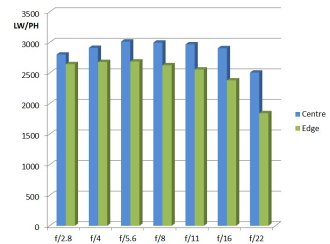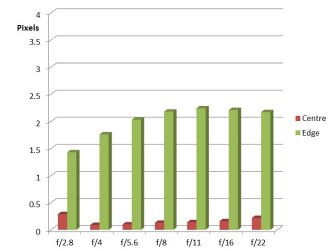HD Pentax-D FA 24-70mm f/2.8 ED SDM WR Review
HD Pentax-D FA 24-70mm f/2.8 ED SDM WR Performance
In a similar way to the other new lenses released, the 24-70mm is definitely of the same design ethos. That is, very good sharpness throughout, regardless of aperture, focal length or centre or edge of the image. The degree of balance is remarkable and is clearly intended to make the most of the entire 35mm-format image area.
At 24mm distortion is -3.47% barrel, typical for such a wide angle. CA is highly controlled at the centre of the field. At the edges CA is visible, but can, of course, be corrected in software or in the in-camera JPEG output. For the purposes of reviews, such correction is switched off.
How to read our charts
The blue column represents readings from the centre of the picture frame at the various apertures and the green is from the edges.The scale on the left side is an indication of actual image resolution as LW/PH and is described in detail above. The taller the column, the better the lens performance.
For this review, the lens was tested on a Pentax K-1 using Imatest.
How to read our charts
Chromatic aberration is the lens' inability to focus on the sensor or film all colours of visible light at the same point. Severe chromatic aberration gives a noticeable fringing or a halo effect around sharp edges within the picture. It can be cured in software.
Apochromatic lenses have special lens elements (aspheric, extra-low dispersion etc) to minimise the problem, hence they usually cost more.
For this review, the lens was tested on a Pentax K-1 using Imatest.
24mm sharpness is of an equally high standard across the whole area from f/2.8 to f/22 at the centre and from f/2.8 to f/11 at the edges, rating very good levels until we get to the edges at f/16 and f/22 where it tails off to good and fair levels respectively.
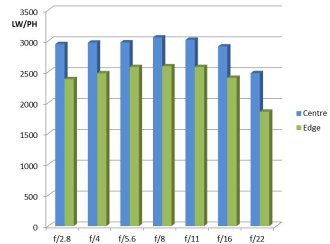 |
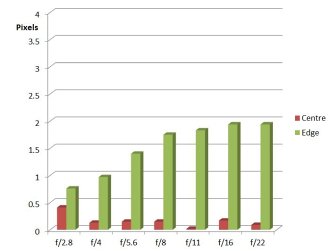 |
| MTF @ 35mm | CA @ 35mm |
At 35mm distortion is a modest -0.141% barrel, which is insignificant in normal photography. CA at the centre is almost non-existent, but it is visible at the edges.
35mm sharpness is pretty much the same as at 24mm, and does not tail off as many zoom lenses do as we zoom into the longer lengths. It achieves very good levels at the centre over all apertures from f/2.8 to f/22. It starts off as good at the edges at f/2.8, is very good from f/4 to f/16 and drops to good at f/22. As with all the focal lengths with this lens, there is a very high degree of consistency between the resolution figures centre and edge which is impressive.
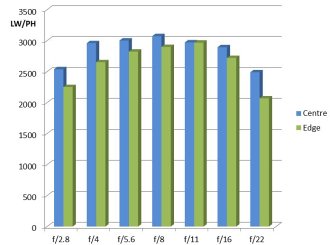 |
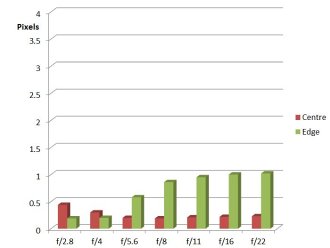 |
| MTF @ 50mm | CA @ 50mm |
50mm gives us a figure of +1.03% pincushion distortion, very acceptable for most purposes. The CA values are very low centre and edge and any residual fringing can be easily removed.
50mm sharpness remains at the same high level as before, giving very good sharpness from f/2.8 to f/16, both centre and edge. Diffraction sets in at f/22 but we still have very good results at the centre and it is only at the edges that it drops to good levels.
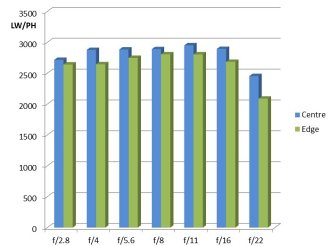 |
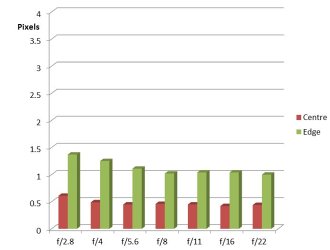 |
| MTF @ 70mm | CA @ 70mm |
70mm gives +1.45% pincushion distortion, again very acceptable. CA is still very well controlled, although with slightly higher levels than at other apertures. It can still be corrected in software if desired.
70mm sharpness still retains the same very good standard and still shows the even performance across the frame that is evident all through this lens's focal lengths. It remains good at f/22, which is always useful to have as an option even though no lens will perform at its best at such a small aperture.
Bokeh, the quality of the out of focus areas, is something that we give much more priority to than in the past. The 24-70mm shows lovely smooth transition in those areas and a very pleasant bokeh effect. There are qualities that cannot necessarily be measured in a lens, but the net effect is a very visually appealing image and this lens certainly has that.
Flare resistance is also vital, especially in a wide angle with its relatively exposed front element. It seems that the new Pentax HD (High Definition) coating works very well indeed, and flare was not found in any of the images shot into the light.
Value For Money
The HD Pentax-D FA 24-70mm f/2.8 ED SDM WR is priced at £1149, although in bundles with the K-1 is can be as little as £1019. Buying with the camera body may well be a good route to take.
The 24-70mm f/2.8 lens is quite a popular choice amongst all the other makers' ranges, although there are none available in Pentax fit at this time. To put the price in perspective, Canon users have the EF 24-70mm f/2.8L II USM (£1400) and the EF 24-70mm f/4L IS USM (£675). Nikon offers the Nikon 24-70mm f/2.8 G AF-S ED (£1399) and Sony the Carl Zeiss 24-70mm f/2.8 ZA SSM II Vario-Sonnar T* (£1349).
Even at its introductory price, and prices inevitably fall with time, the Pentax looks very good value against the other marques.
Add your message
Please login here or if you've not registered, you can register here. Registering is safe, quick and free.
photodo Stats
428 MTF tests
74 in-depth photodo reviews
100+ users join each day
Help the lens community by reviewing or rating a lens today via our lens search
Latest Lens Reviews
- Chinon 28mm f/2.8 Vintage Lens Review
- Canon EF 70-200mm f/4L IS II USM Lens Review
- Samyang AF 85mm f/1.4 EF Review
- Sigma 70mm f/2.8 DG Macro Art Review
- Samyang AF 24mm f/2.8 FE Review
- Meike 50mm f/1.7 Review
- Tamron 70-210mm f/4 Di VC USD Review
- Lensbaby Burnside 35mm f/2.8 Review
- Asahi Super Takumar 50mm f/1.4 Review
- Asahi Super-Multi-Coated Takumar 135mm f/3.5 Review
